unit3第四课时_20090326091918431_20090424080733658
- 格式:doc
- 大小:23.00 KB
- 文档页数:1
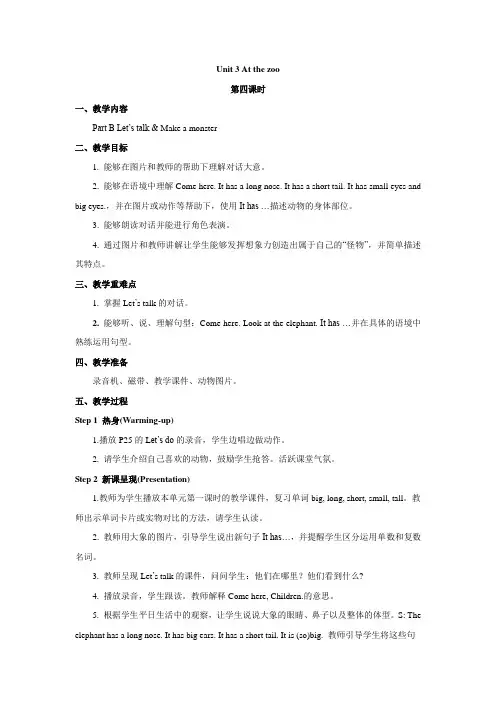
Unit 3 At the zoo第四课时一、教学内容Part B Let’s talk & Make a monster二、教学目标1. 能够在图片和教师的帮助下理解对话大意。
2. 能够在语境中理解Come here. It has a long nose. It has a short tail. It has small eyes and big eyes.,并在图片或动作等帮助下,使用It has …描述动物的身体部位。
3. 能够朗读对话并能进行角色表演。
4. 通过图片和教师讲解让学生能够发挥想象力创造出属于自己的“怪物”,并简单描述其特点。
三、教学重难点1. 掌握Let’s talk的对话。
2. 能够听、说、理解句型:Come here. Look at the elephant. It has …并在具体的语境中熟练运用句型。
四、教学准备录音机、磁带、教学课件、动物图片。
五、教学过程Step 1 热身(Warming-up)1.播放P25的L et’s do的录音,学生边唱边做动作。
2. 请学生介绍自己喜欢的动物,鼓励学生抢答。
活跃课堂气氛。
Step 2 新课呈现(Presentation)1.教师为学生播放本单元第一课时的教学课件,复习单词big, long, short, small, tall。
教师出示单词卡片或实物对比的方法,请学生认读。
2. 教师用大象的图片,引导学生说出新句子It has…,并提醒学生区分运用单数和复数名词。
3. 教师呈现Let’s talk的课件,问问学生:他们在哪里?他们看到什么?4. 播放录音,学生跟读。
教师解释Come here, Children.的意思。
5. 根据学生平日生活中的观察,让学生说说大象的眼睛、鼻子以及整体的体型。
S: The elephant has a long nose. It has big ears. It has a short tail. It is (so)big. 教师引导学生将这些句子用and连接在一起,并带读:Look at the elephant. It’s so big. It has a long nose and a short tail. It has small eyes and big ears.5. 再次播放Let’s talk的录音, 请学生尝试复述听到的句子并说出汉语意思。
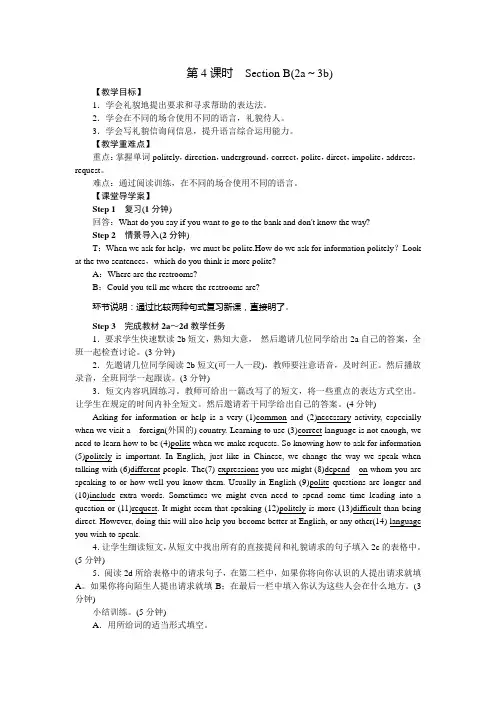
第4课时Section B(2a~3b)【教学目标】1.学会礼貌地提出要求和寻求帮助的表达法。
2.学会在不同的场合使用不同的语言,礼貌待人。
3.学会写礼貌信询问信息,提升语言综合运用能力。
【教学重难点】重点:掌握单词politely,direction,underground,correct,polite,direct,impolite,address,request。
难点:通过阅读训练,在不同的场合使用不同的语言。
【课堂导学案】Step 1复习(1分钟)回答:What do you say if you want to go to the bank and don't know the way?Step 2情景导入(2分钟)T:When we ask for help,we must be polite.How do we ask for information politely?Look at the two sentences,which do you think is more polite?A:Where are the restrooms?B:Could you tell me where the restrooms are?环节说明:通过比较两种句式复习新课,直接明了。
Step 3完成教材2a~2d教学任务1.要求学生快速默读2b短文,熟知大意,然后邀请几位同学给出2a自己的答案,全班一起检查讨论。
(3分钟)2.先邀请几位同学阅读2b短文(可一人一段),教师要注意语音,及时纠正。
然后播放录音,全班同学一起跟读。
(3分钟)3.短文内容巩固练习。
教师可给出一篇改写了的短文,将一些重点的表达方式空出。
让学生在规定的时间内补全短文。
然后邀请若干同学给出自己的答案。
(4分钟) Asking for information or help is a very (1)common and (2)necessary activity, especially when we visit a foreign(外国的) country. Learning to use (3)correct language is not enough, we need to learn how to be (4)polite when we make requests. So knowing how to ask for information (5)politely is important. In English, just like in Chinese, we change the way we speak when talking with (6)different people. The(7) expressions you use might (8)depend__on whom you are speaking to or how well you know them. Usually in English (9)polite questions are longer and (10)include extra words. Sometimes we might even need to spend some time leading into a question or (11)request. It might seem that speaking (12)politely is more (13)difficult than being direct. However, doing this will also help you become better at English, or any other(14) language you wish to speak.4.让学生细读短文,从短文中找出所有的直接提问和礼貌请求的句子填入2c的表格中。
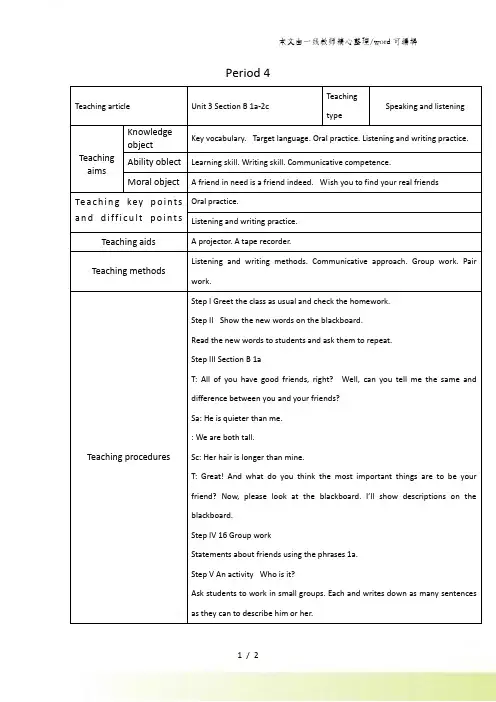
Period 4Teaching article Unit 3 Section B 1a-2c TeachingtypeSpeaking and listeningTeaching aims KnowledgeobjectKey vocabulary. Target language. Oral practice. Listening and writing practice. Ability oblect Learning skill. Writing skill. Communicative competence.Moral object A friend in need is a friend indeed. Wish you to find your real friendsTe a c h in g ke y p o int s a n d d i f f i c u l t p o i n t s Oral practice.Listening and writing practice.Teaching aids A projector. A tape recorder.Teaching methods Listening and writing methods. Communicative approach. Group work. Pair work.Teaching procedures Step I Greet the class as usual and check the homework.Step II Show the new words on the blackboard.Read the new words to students and ask them to repeat.Step III Section B 1aT: All of you have good friends, right? Well, can you tell me the same and difference between you and your friends?Sa: He is quieter than me.: We are both tall.Sc: Her hair is longer than mine.T: Great! And what do you think the most important things are to be your friend? Now, please look at the blackboard. I’ll show descriptions on the blackboard.Step IV 16 Group workStatements about friends using the phrases 1a.Step V An activity Who is it?Ask students to work in small groups. Each and writes down as many sentences as they can to describe him or her.Step VI 2aIn this activity first ask students to look at the names and the first column of the talbe.Tell students they will hear an interviewer talking to Holly and Maria. They are talking about what they like about their best friends.Step VII 2bLet students look at the rest of the chart. Read the heading at the top of each column.The same as best friend. Different from best friend.Tell students we’ll listen aga in. Ask students to fill in the chart. How are Holly and Maria the same as and different from their best friends?Step VIII Homework and SummaryToday we’ve recycled some key vocabulary and learnt some new words. And we’ve learnt to talk about our best fri ends.After class write down five statements about what is important in a best friend. Please remember you can write a false statement among the five statements. Next class we’ll do a game.Blackboard design Unit 3 I’m more outgoing than my sisterA good friend …Has cool clothes Is popular in school Likes to do the same things as me Is good at sportIs good at school work Makes me laughHomework After class write down five statements about what is important in a best friend. Please remember you can write a false statement among the five statements. Next class we’ll do a game.。
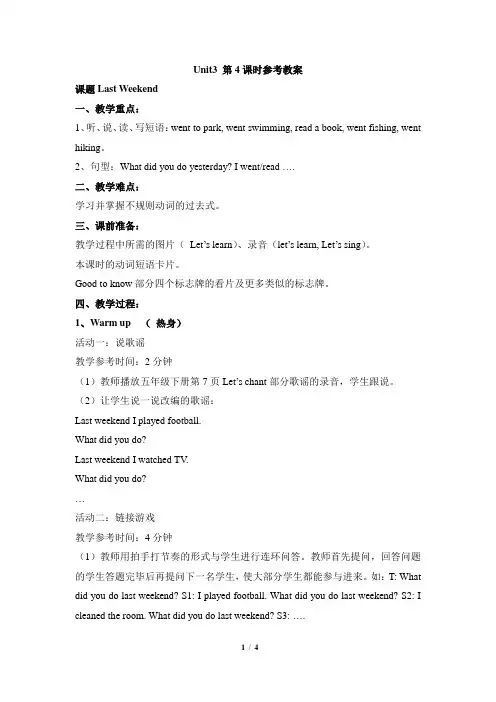
Unit3 第4课时参考教案课题Last Weekend一、教学重点:1、听、说、读、写短语:went to park, went swimming, read a book, went fishing, went hiking。
2、句型:What did you do yesterday? I went/read ….二、教学难点:学习并掌握不规则动词的过去式。
三、课前准备:教学过程中所需的图片(Let’s learn)、录音(let’s learn, Let’s sing)。
本课时的动词短语卡片。
Good to know部分四个标志牌的看片及更多类似的标志牌。
四、教学过程:1、Warm up (热身)活动一:说歌谣教学参考时间:2分钟(1)教师播放五年级下册第7页Let’s chant部分歌谣的录音,学生跟说。
(2)让学生说一说改编的歌谣:Last weekend I played football.What did you do?Last weekend I watched TV.What did you do?…活动二:链接游戏教学参考时间:4分钟(1)教师用拍手打节奏的形式与学生进行连环问答。
教师首先提问,回答问题的学生答题完毕后再提问下一名学生,使大部分学生都能参与进来。
如:T: What did you do last weekend? S1: I played football. What did you do last weekend? S2: I cleaned the room. What did you do last weekend? S3: ….(2)三个学生一组,教师分别出示Let’s learn A图片,第一名学生要看图说出短语,第二名学生说出这个短语的过去式形式,第三名学生拼出这个短语。
其他学生要对他们的答案进行判断。
2、Presentation (新课呈现)活动三:视听训练教学参考时间:5分钟让学生观看Story time部分教学课件或听录音。
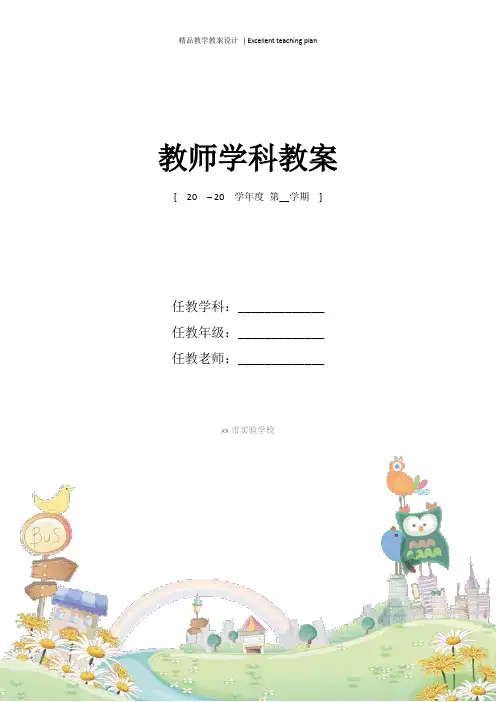
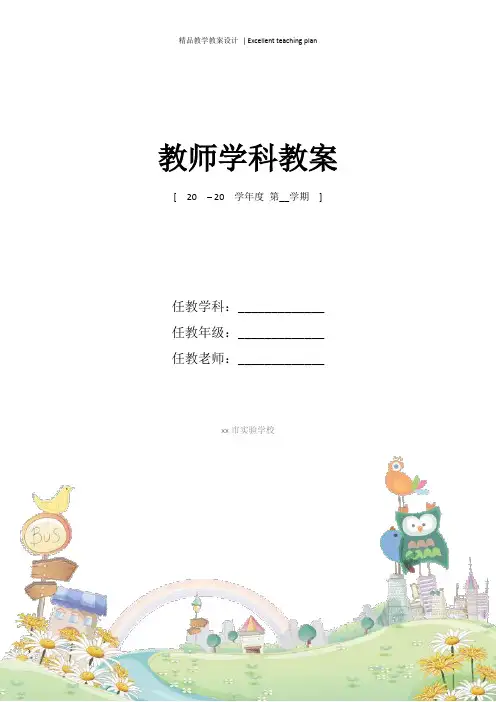
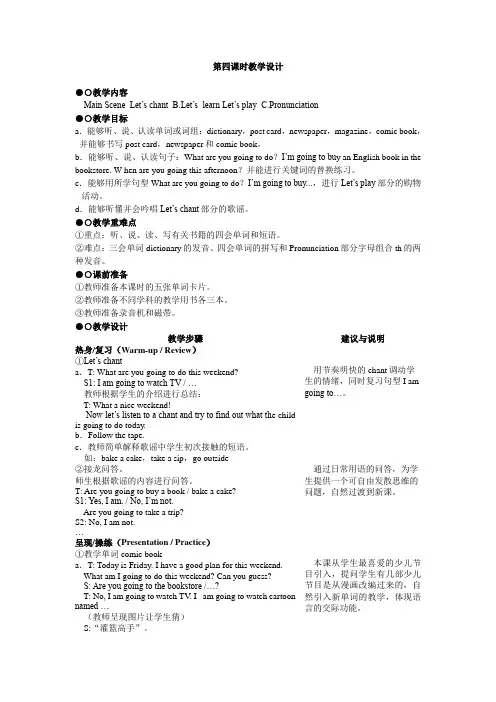
第四课时教学设计●○教学内容Main Scene Let’s chant B.Let’s learn Let’s play C.Pronunciation●○教学目标a.能够听、说、认读单词或词组:dictionary,post card,newspaper,magazine,comic book,并能够书写post card,newspaper和comic book。
b.能够听、说、认读句子:What are you going to do?I’m going to bu y an English book in the bookstore. W hen are you going this afternoon?并能进行关键词的替换练习。
c.能够用所学句型What are you going to do?I’m going to buy...,进行Let’s play部分的购物活动。
d.能够听懂并会吟唱Let’s chant部分的歌谣。
●○教学重难点①重点:听、说、读、写有关书籍的四会单词和短语。
②难点:三会单词dictionary的发音、四会单词的拼写和Pronunciation部分字母组合th的两种发音。
●○课前准备①教师准备本课时的五张单词卡片。
②教师准备不同学科的教学用书各三本。
③教师准备录音机和磁带。
●○教学设计教学步骤建议与说明热身/复习(Warm-up / Review)①Let’s chanta.T: What are you going to do this weekend?S1: I am going to watch TV / …教师根据学生的介绍进行总结:T: What a nice weekend!Now let’s listen to a chant and try to find out what th e child is going to do today.b.Follow the tape.c.教师简单解释歌谣中学生初次接触的短语。
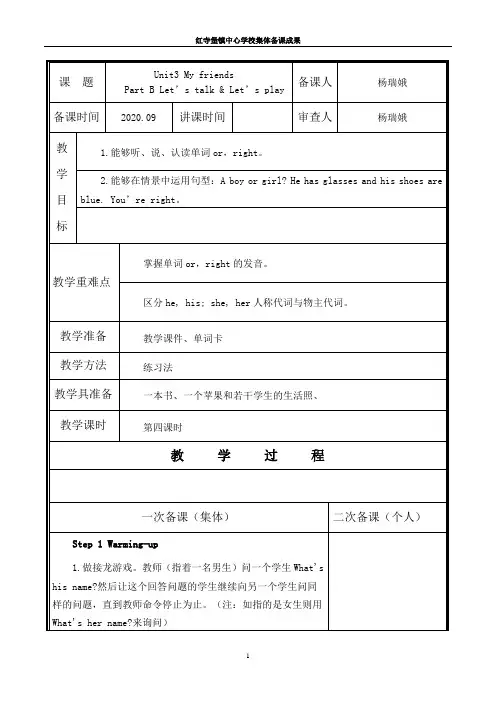
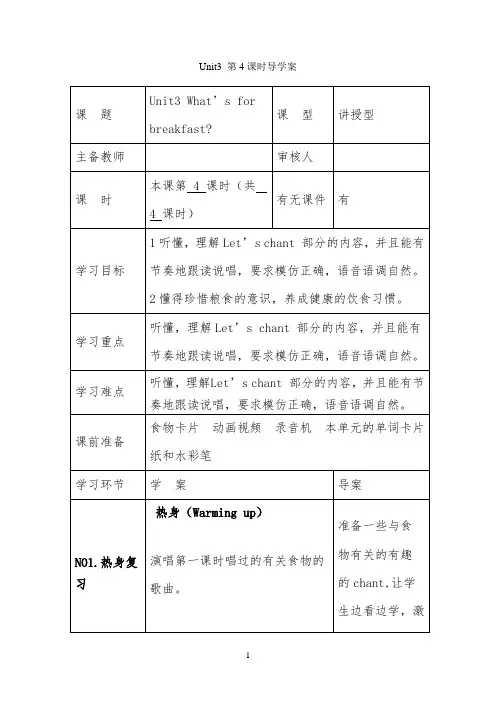
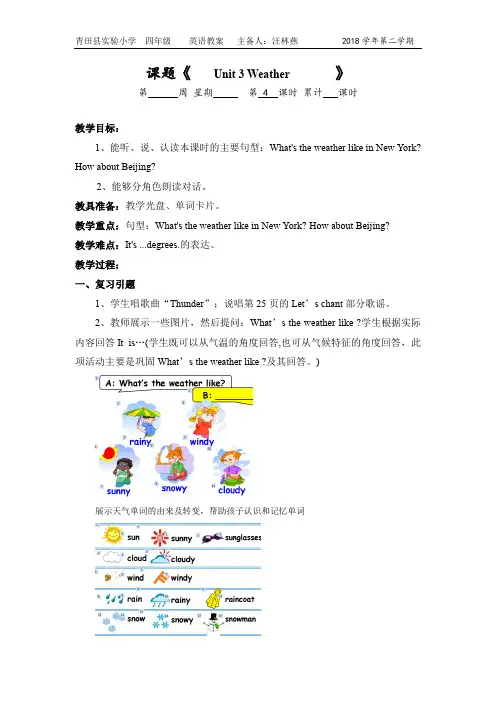
课题《Unit 3 Weather》第周星期第 4 课时累计课时教学目标:1、能听、说、认读本课时的主要句型:What's the weather like in New York? How about Beijing?2、能够分角色朗读对话。
教具准备:教学光盘、单词卡片。
教学重点:句型:What's the weather like in New York? How about Beijing?教学难点:It's ...degrees.的表达。
教学过程:一、复习引题1、学生唱歌曲“Thunder”;说唱第25页的Let’s chant部分歌谣。
2、教师展示一些图片,然后提问:What’s the weather like ?学生根据实际内容回答It is…(学生既可以从气温的角度回答,也可从气候特征的角度回答,此项活动主要是巩固What’s the weather like ?及其回答。
)展示天气单词的由来及转变,帮助孩子认识和记忆单词二、教学新课1、听故事,引导学生了解地方不同天气也不同。
教师让孩子听并提问:What’s the weather like in Beijing?2、听第二遍。
教师提问并回答教师领读:New York,注意学生的发音不要受汉语纽约的干扰,适时纠正。
3、教师适当的给孩子们讲一下摄氏度及华氏度的区别。
4、请学生观看课件,初步理解对话的意思:--Hi, Chen Jie! This is Mark.--Hi, Mark! What’s the weather like in New York?--It’s rainy. How about Beijing? Is it cold?--No, it isn’t. It’s 26 degrees.--26 degrees! That’s cold!--Huh? No, it’s not. It’s warm!6、教师领读;解释意思。
第四课时
教学目标:
1.了解字母组合dr和tr在单词中的发音。
2.看懂、会说、会读P28情景剧。
3.能听懂、会说、会读句型What do you want to be? I want to be…
4.会唱歌曲:They sing happily
教学建议:
1、比较朗读单词 dress, driver, tree, trousers 先请学生看单
词,找规律,小组讨论朗读。
然后由教师纠正领读。
学生自己回忆有哪些字母组合dr和tr的单词。
听录音模仿句子语音、语调。
分组比赛诵读。
2、F. funhouse
(1) < look and read >
指导学生看图、读句,理解小故事的幽默之处。
根据情况也可以让学生进行短剧表演。
(2)Do a survey
教师可以先问问部分学生自己想当的职业是什么,再让学生进行调查。
(3)让学生跟学歌曲
课堂检测:
完成补充习题有关练习
作业布置:
★完成一课一练有关练习
★★有表情地表演P28的对话。
★★★背出P27对话。